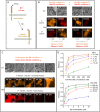Quantitative determination of fluorescence labeling implemented in cell cultures
- PMID: 37697318
- PMCID: PMC10496409
- DOI: 10.1186/s12915-023-01685-0
Quantitative determination of fluorescence labeling implemented in cell cultures
Abstract
Background: Labeling efficiency is a crucial parameter in fluorescence applications, especially when studying biomolecular interactions. Current approaches for estimating the yield of fluorescent labeling have critical drawbacks that usually lead them to be inaccurate or not quantitative.
Results: We present a method to quantify fluorescent-labeling efficiency that addresses the critical issues marring existing approaches. The method operates in the same conditions of the target experiments by exploiting a ratiometric evaluation with two fluorophores used in sequential reactions. We show the ability of the protocol to extract reliable quantification for different fluorescent probes, reagents concentrations, and reaction timing and to optimize labeling performance. As paradigm, we consider the labeling of the membrane-receptor TrkA through 4'-phosphopantetheinyl transferase Sfp in living cells, visualizing the results by TIRF microscopy. This investigation allows us to find conditions for demanding single and multi-color single-molecule studies requiring high degrees of labeling.
Conclusions: The developed method allows the quantitative determination and the optimization of staining efficiency in any labeling strategy based on stable reactions.
Keywords: Fluorescence microscopy; Fluorescent labeling; Membrane receptors; Sfp phosphopantetheinyl transferase; Single-molecule imaging; Single-particle tracking.
© 2023. BioMed Central Ltd., part of Springer Nature.
Conflict of interest statement
The authors declare no competing interests.
Figures






References
-
- Reina F, Eggeling C, Lagerholm BC. Single particle tracking on cells reveals new insights into membrane compartmentalization and lipid dynamics. Biophys J. 2022;121:302a. doi: 10.1016/j.bpj.2021.11.1248. - DOI
Publication types
MeSH terms
Substances
LinkOut - more resources
Full Text Sources
Research Materials

